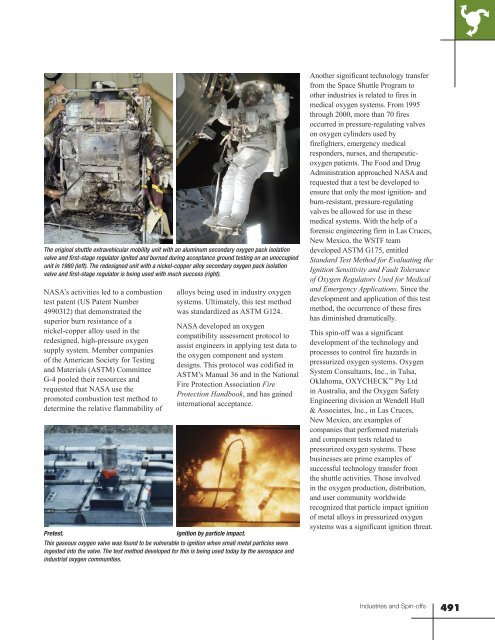The DeBakey VAD ® functions as a “bridge toheart transplant” by pumping blood throughoutthe body to keep critically ill patients alive until adonor heart is available.These illustrations show a visual comparison ofthe original ventricular assist device (top) <strong>and</strong> theunit after modifications by <strong>NASA</strong> researchers(center <strong>and</strong> bottom). Adding the <strong>NASA</strong>improvements to the MicroMed DeBakey VAD ®eliminated the dangerous backflow of blood byincreasing pressure <strong>and</strong> making flow morecontinuous. The highest pressure around theblade tips are shown in magenta. The blue/greencolors illustrate lower pressures.So, what was it that Dave Saucier <strong>and</strong>the other engineers at JSC thought theyknew that could help make a VAD workbetter, be smaller, <strong>and</strong> help thous<strong>and</strong>sof people seriously ill with heart failure<strong>and</strong> waiting for a transplant? Well,these folks had worked on <strong>and</strong>optimized the turbopumps for theshuttle main engines that happen tohave requirements in common withVAD. The turbopumps needed tomanage high flow rates, minimizeturbulence, <strong>and</strong> eliminate air bubbles.These are also requirements dem<strong>and</strong>edof a VAD by the blood <strong>and</strong> body.In the beginning, VADs had problemssuch as damaging red blood cells <strong>and</strong>having stagnant areas leading to theincreased likelihood of blood clotdevelopment. Red blood cells areessential for carrying oxygen to thetissues of the body. Clots can preventblood from getting to a tissue, resultingin lack of oxygenation <strong>and</strong> buildup oftoxic waste products that lead to tissuedeath. Once engineers resolved theVAD-induced damage to red blood cells<strong>and</strong> clot formation, the device couldenter a new realm of clinical application.In 1996 <strong>and</strong> 1999, engineers from JSC<strong>and</strong> <strong>NASA</strong> Ames Research Center <strong>and</strong>medical colleagues from the BaylorCollege of Medicine were awarded USpatents for a method to reduce pumpingdamage to red blood cells <strong>and</strong> for thedesign of a continuous flow heart pump,respectively. Both of these wereexclusively licensed to MicroMedCardiovascular, Inc. (Houston, Texas)for the further development of the small,implantable DeBakey VAD ® .MicroMed successfully implanted thefirst DeBakey VAD ® in 1998 in Europe<strong>and</strong>, to date, has implanted 440 VADs.MicroMed’s HeartAssist5 ® (the 2009version of the DeBakey VAD ® )weighs less than 100 grams (3.5 oz),is implanted in the chest cavity inthe pericardial space, which reducessurgical complications such asinfections, <strong>and</strong> can operate for as manyas 9 hours on battery power, therebyresulting in greater patient freedom.This device not only acts as a bridgeto transplant, allowing patients to livelonger <strong>and</strong> better lives while waitingfor a donor heart, it is now a destinationtherapy. People are living out theirlives with the implanted device <strong>and</strong>some are even experiencing recovery,which means they can have the deviceexplanted <strong>and</strong> not require a transplant.Making Oxygen Systems SafeHospitals, ambulances, industrialcomplexes, <strong>and</strong> <strong>NASA</strong> all use 100%oxygen <strong>and</strong> all have experienced tragicfires in oxygen-enriched atmospheres.Such fires demonstrated the needfor knowledge related to the use ofmaterials in oxygen-enrichedatmospheres. In fact, on April 18, 1980,an extravehicular mobility unit plannedfor use in the Space Shuttle Programwas destroyed in a dramatic fireduring acceptance testing. In responseto these fire events, <strong>NASA</strong> developeda test method <strong>and</strong> procedures thatsignificantly reduced the danger.The method <strong>and</strong> procedures are nownational <strong>and</strong> international industrialst<strong>and</strong>ards. <strong>NASA</strong> White S<strong>and</strong>s TestFacility (WSTF) also offered courseson oxygen safety to industry <strong>and</strong>government agencies.During the shuttle era, <strong>NASA</strong> madesignificant advances in testing <strong>and</strong>selecting materials for use inhigh-pressure, oxygen-enrichedatmospheres. Early in the shuttle era,engineers became concerned that smallmetal particles could lead to ignitionif the particles were entrained in the277°C (530°F) oxygen that flowedthrough the shuttle’s Main PropulsionSystem gaseous oxygen flow controlvalve. After developing a particleimpact test, <strong>NASA</strong> determined that thestainless-steel valve was vulnerable toparticle impact ignition. Later testingrevealed that a second gaseous oxygenflow control valve, fabricated from analloy with nickel chromium, Inconel ®718, was also vulnerable to particleimpact ignition. Finally, engineersshowed that an alloy with nickel-copper,Monel ® , was invulnerable to ignition byparticle impact <strong>and</strong> consequently wasflown in the Main Propulsion Systemfrom the mid 1980s onward.490Industries <strong>and</strong> Spin-offs
The original shuttle extravehicular mobility unit with an aluminum secondary oxygen pack isolationvalve <strong>and</strong> first-stage regulator ignited <strong>and</strong> burned during acceptance ground testing on an unoccupiedunit in 1980 (left). The redesigned unit with a nickel-copper alloy secondary oxygen pack isolationvalve <strong>and</strong> first-stage regulator is being used with much success (right).<strong>NASA</strong>’s activities led to a combustiontest patent (US Patent Number4990312) that demonstrated thesuperior burn resistance of anickel-copper alloy used in theredesigned, high-pressure oxygensupply system. Member companiesof the American Society for Testing<strong>and</strong> Materials (ASTM) CommitteeG-4 pooled their resources <strong>and</strong>requested that <strong>NASA</strong> use thepromoted combustion test method todetermine the relative flammability ofalloys being used in industry oxygensystems. Ultimately, this test methodwas st<strong>and</strong>ardized as ASTM G124.<strong>NASA</strong> developed an oxygencompatibility assessment protocol toassist engineers in applying test data tothe oxygen component <strong>and</strong> systemdesigns. This protocol was codified inASTM’s Manual 36 <strong>and</strong> in the NationalFire Protection Association FireProtection H<strong>and</strong>book, <strong>and</strong> has gainedinternational acceptance.Pretest.Ignition by particle impact.This gaseous oxygen valve was found to be vulnerable to ignition when small metal particles wereingested into the valve. The test method developed for this is being used today by the aerospace <strong>and</strong>industrial oxygen communities.Another significant technology transferfrom the Space Shuttle Program toother industries is related to fires inmedical oxygen systems. From 1995through 2000, more than 70 firesoccurred in pressure-regulating valveson oxygen cylinders used byfirefighters, emergency medicalresponders, nurses, <strong>and</strong> therapeuticoxygenpatients. The Food <strong>and</strong> DrugAdministration approached <strong>NASA</strong> <strong>and</strong>requested that a test be developed toensure that only the most ignition- <strong>and</strong>burn-resistant, pressure-regulatingvalves be allowed for use in thesemedical systems. With the help of aforensic engineering firm in Las Cruces,New Mexico, the WSTF teamdeveloped ASTM G175, entitledSt<strong>and</strong>ard Test Method for Evaluating theIgnition Sensitivity <strong>and</strong> Fault Toleranceof Oxygen Regulators Used for Medical<strong>and</strong> Emergency Applications. Since thedevelopment <strong>and</strong> application of this testmethod, the occurrence of these fireshas diminished dramatically.This spin-off was a significantdevelopment of the technology <strong>and</strong>processes to control fire hazards inpressurized oxygen systems. OxygenSystem Consultants, Inc., in Tulsa,Oklahoma, OXYCHECK Pty Ltdin Australia, <strong>and</strong> the Oxygen SafetyEngineering division at Wendell Hull& Associates, Inc., in Las Cruces,New Mexico, are examples ofcompanies that performed materials<strong>and</strong> component tests related topressurized oxygen systems. Thesebusinesses are prime examples ofsuccessful technology transfer fromthe shuttle activities. Those involvedin the oxygen production, distribution,<strong>and</strong> user community worldwiderecognized that particle impact ignitionof metal alloys in pressurized oxygensystems was a significant ignition threat.Industries <strong>and</strong> Spin-offs491
















